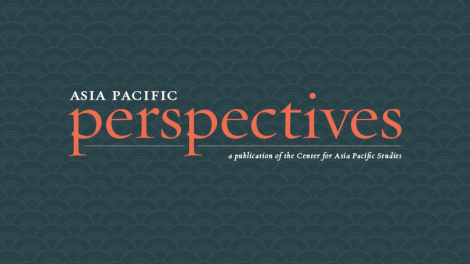
Volume XIII: Spring/Summer 2015
Guest Editor's Introduction

Asia Pacific Perspectives is a journal with broad vision. The interdisciplinary work highlighted in its pages considers the links between Asian states, and between the region and the world. As an international historian, I am pleased to be guest editor of an issue that maintains the expansive view which APP is known for, and that ties the present to the past.
In this issue, Chris White considers one legacy of China’s nineteenth century interaction with the West, the practice of Christianity in southern China. Drawing on his extensive fieldwork, White argues that local funeral practices strengthen and engage modern Chinese Christian communities, while also serving as a tool for proselytization. Thomas French too blends the past and present, bringing digital mapping tools to visualize historical records on fishing vessel captures in the waters of North East Asia following World War II. This approach offers a new way to evaluate the current maritime sovereignty disputes between China, Korea, and Japan.
Returning to the theme of East-West relations, Brandon Seto provides a survey of the role racism has played in American relations with China and Japan. From World War to Cold War, Seto argues, American understanding of these major Asian powers has been dominated by themes of paternalism and fear. Seto describes the fluidity with which Americans shifted between these two paradigms, as China and Japan alternated positions as allies and enemies of the United States. Ulli Jamitzky returns the focus to modern Asia, as he examines the movement within Japan against large multilateral trade deals like the Trans-Pacific Partnership (TPP). His article examines Japan’s domestic politics, with implications for the country’s future as a major trading power.
This issue also includes a Think Piece, in which cultural anthropologist Pablo Figueroa analyzes the claim of “uniqueness” in Japanese art. Considering the history of art photography in Japan, he finds that globalization and social media have a profound impact on Japanese artists today, and that their work is best understood within the context of a globalized art community.
The editors are pleased to include on our website the winner of the graduate student essay prize. Kilby Hammond, a recent graduate of the Masters in Asia Pacific Studies program at USF, has written a thoughtful essay examining the experiences of Japanese repatriates following World War II. He uses memoirs and secondary literature to explore the connections between repatriation, questions of war guilt, national identity, and memory.
We thank Jan Vaeth, who is leaving the Center for Asia Pacific Studies this month, for his dedication and work on the journal. We also thank Amanda Dzida for her efforts in web editing to bring Asia Pacific Perspectives to you, its readers.
Dayna Barnes
Guest Editor and 2014–15 Kiriyama Fellow
Center for Asia Pacific Studies
University of San Francisco
